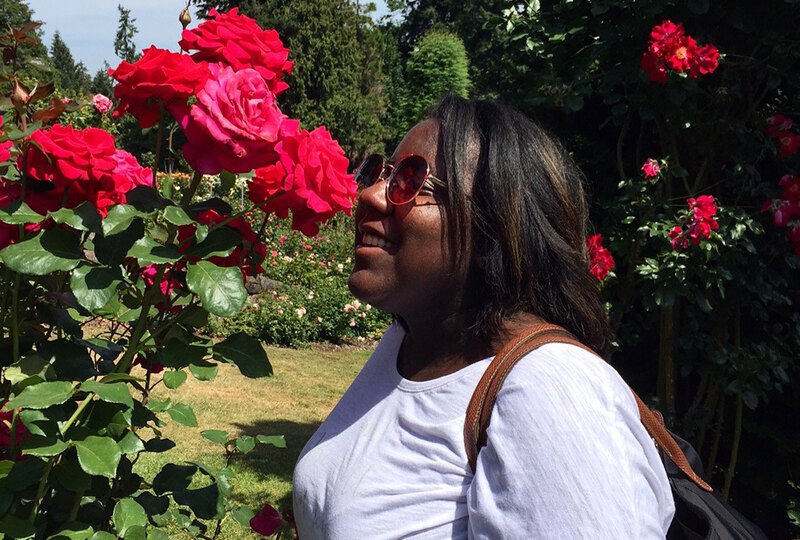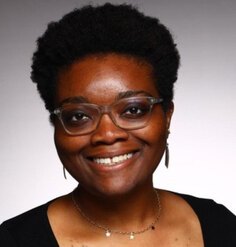Perspectives: Jescelle Major

February 12, 2020
Jescelle Major, CPRP, is an Associate at BERK, an interdisciplinary public policy consultancy specializing in policy, financial and economic analysis; facilitation, stakeholder engagement and community outreach; strategic planning; and information design and communications. She previously worked at Mithun as a landscape designer and is active in her community by serving on the Seattle Arts Commission, co-chairing the Public Art Advisory Committee, serving on the Board of Directors for Sawhorse Revolution, and volunteering with ARCADE and Design in Public.
What drew you to landscape architecture?
Can I say I don’t know? I’m not sure that there was any one thing. Similarly, the collection of all of my experiences still might not have me firmly seated and cozy in the landscape architecture canon. I would hope there is room for me or others like me to push and pull at the edges of the profession so that my voice and similar ones will be captured and carried.
I have always been creative (if it is okay to say that about yourself) and into art, design, and environmental science. I went to Design and Architecture Senior High in the Miami Design District. There I studied architecture, took college-credited studios, and felt sure that was it for me, I’d found my career. I was obsessive about applying to colleges, only ones with architecture programs and a football team, without the suffocating debt. In my first year at the University of Florida, I realized the architecture attitude wasn’t quite right, and not for a lifetime. I was a landscape architecture major for a blink while I was applying to the inaugural cohort of the the Design, Construction and Planning college’s BS degree in Sustainability and the Built Environment. That program was a perfect fit.
It’s only times like these I remember that one transitional semester is when I learned of landscape architecture. I didn't even begin to give it a fair shake until it was time to consider graduate school. I applied across disciplines from lighting to criticism to landscape architecture. I was awarded a graduate assistantship at LSU’s Robert Reich School of Landscape Architecture. I was piqued by the ways landscape was so of a place, that it deftly switched between intimate and global scales, and had cultural and science lenses sturdy enough to hold my sustainability education.
I am so analytical. It is a strength and sometimes a weakness. Luckily, I found a profession where the first step and the iterative motor oil is analysis. I wasn’t quite drawn but found the right place to root in the field of landscape architecture.
What is driving you professionally right now?
Freedom, isolation and pressure.
I currently have a lot of authorship and freedom in my work to be imaginative. I’d say that is a big driver because of the hope of success and fear of failure that comes with trying something new or challenging traditions and ultimately having it attached to your name. I want to have something to show for the additional effort.
Working in a field where your lived experiences and the identities you hold are so underrepresented can be extremely isolating. This isolation makes seeking mentorship and guidance more complicated, especially when leadership representing people of color, women of color, low-incomes etc. are frankly just not in the ranks. Visibility and networking is important, so I am driven by getting people who are already doing the work seen and credited as well as expanding visibility for myself and others. With any success, the next wave doesn’t have to feel so isolated, or more might continue to explore the profession instead of self-selecting out.
With freedom and isolation comes the pressure to get it right and to speak up. I feel its presence all of the time but I am not deterred or threatened by it. At least not today. It could be the wrong sense to use but when pressure is awakened, I feel like I am onto something greater.
What challenges is your landscape architecture background helping you to address right now?
Relating and communicating.
One of the principals in my firm spoke to me about the notion of me being a qualitative analyst. That really resonated with me. I think landscape architecture, at least in the context in which I was taught, is so much about relating and being relatable. Our designs were to be of a place — its history, ecology, culture. To do this, we listened and analyzed — we had to get comfortable, quickly. That is how I still approach my work now. I work in communities I don’t belong to or know the first thing about, but because I value their lives and stories, because I have the training to listen and reflect back their vision in drawings, in model, in prose or policy, I get to belong there too and create something enduring and reflective. In turn, I think people, municipalities, and organizations feel empowered to own, maintain, and communicate confidently about what we've collectively made. That is the great gift I feel like I offer up thanks to landscape school.
In a time when we don't value each other enough, when respect is diminishing, it is the most important set of ideals I can insert back into practice, discourse, and my own catalog of work. I am working everywhere — parks planning, housing evaluations and studies, homelessness, library plans, art scans, placemaking strategies, and anything in between — and my background in landscape is critical in doing any and all of it well, in a way someone else would not.
What challenge would you give emerging leaders?
I feel like the cast of who is emerging and reemerging looks so different in our profession when compared to others. I would suggest that anyone trying to be a leader should endeavor to be more than a party of one, continuously. There should of course be individualism, solo expedition, and exploration but our profession is born out of the commons and the protection and betterment should subsequently be rooted in that. A person who doesn't bring along and empower those around them might be adept at monologues but they are not a leader. When one is in a state of emerging it is even more reason to learn and teach, always being in dialog and looking for measurable change or progress. Age and experience don’t limit your leadership, they change it. If I were to write a guidebook for emerging or even continued leadership it would center on these ideas:
- If there is a simple answer, choose that one. The profession trends towards complicated — big. Sometimes nuanced a version of the tried and true is the right fit. Reaching more people and abating more threats is much more about where you are precise and where you are flexible than how big you can be. Simple and bold are not mutually exclusive.
- If there is nobody to look up to, look inward — its you. So often we’re limited by our own disbelief in our abilities or experiences. Instead of speaking up and asking for others to mind the gap with us, the void remains full of timid "what-ifs" and "someone’s who shoulds". But there is nobody who will. Who better than you?
- Safety first. You need your health to be good at your work. Your psychological safety is important in every space you go into. You know what the line is for you, express it, and you don't have to cross it. Create, foster, and demand safety in the work you design for others and the space you hold for yourself and peers.
- Document it. Take the credit, spread the word. Humility has its place but sometimes you have to amplify your own good works, deeds, and ideas so that others might see and help implement, replicate, or spread them throughout the commons. Hansel and Gretel. Leave breadcrumbs for those in your wake to follow.
- Curate and Critique. This one is maybe not in everyone's nature but that doesn't make it any less important. We are trained to give and withstand critique unlike any other profession. We also see trends and themes in varied ways, in part because of training and practice, and should curate exhibitions (literal and metaphorical) to be reflective and expansive about the work. Also encompassed is the research and discourse we are involved in. Solutions that are realistic, resilient, and culturally literate need to be critical of the current state of the world. The worlds of design, science, policy, medicine/healing, and anthropology need to collaborate and we should be curating and critiquing the holes in our interprofessionalism as well as the work.
Where do you think the profession needs to go from here?
For me, if it is not rooted in justice, then I don’t want it. Further, I don’t think the profession should be prioritizing anything that doesn’t advance that work. There is room for every type of practice, and I get that and wish it to be true more than anyone... but the resources? I can’t imagine that we as a profession rally behind and put our collective resources into beauty or functionality or innovation if it isn't also just.
I wholeheartedly believe our profession should retain pride in its history and traditions. But more than fighting for contrived sense of place and protections for the work we have always done (with or without credit), the profession should be morphing, expanding, and changing to make products and gestures that are reflective of the true place and communities.
In a profession that seems to be stuck on big moves, gestures, and declaration, I hope we begin to negotiate the scales, as we’ve been trained to do to in moving towards making real and measurable differences towards an accessible and inclusive public realm. I hope we are generous and innovative in the private pieces that frame the public ones, and I hope we begin to do more than preach when we speak about restorative justice or conservation work. What could we design if we really let the rivers sway the way they were meant to, cultures mix and retreat rhythmically, and challenged ourselves boundlessly?
I am curious to see what landscape architecture could look like if we sought to choreograph with the systems instead of containing and dancing around them.
LAF's Perspectives interview series showcases landscape architects from diverse backgrounds discussing how they came to the profession and where they see it heading. Any opinions expressed in this interview belong solely to the author. Their inclusion in this article does not reflect endorsement by LAF.











